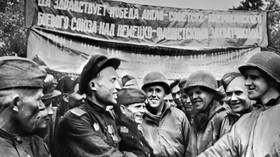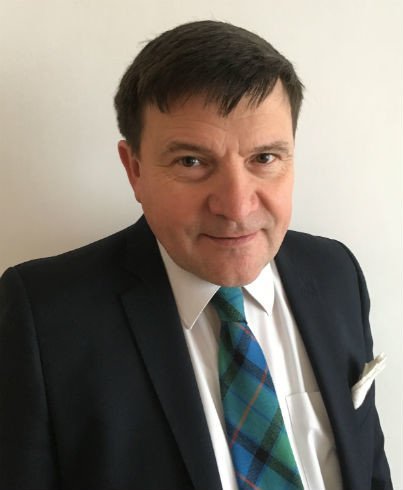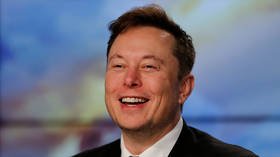Elbe Day 75th anniversary is a powerful reminder that Russian-American friendship IS POSSIBLE

On April 25, 1945, Soviet and American troops warmly embraced each other at the Elbe in Germany. The friendship between the two superpowers that existed then needs to be revived if the world's greatest problems are to be solved.
It’s one World War II anniversary that, if you live outside of Russia, you probably haven't heard of.
Elbe Day, when the soldiers of the Red Army 5th Guards, commanded by General Alexey Zhadov, and the US First Army of General Courtenay Hodges met up at the famous German river, was not only an important step towards the ending of World War II and the defeat of the Nazis, it also held out the hope of a better future and close superpower collaboration after that conflict was over.
The sight of American and Russian troops with their arms around each other would horrify foaming-at-the-mouth Russophobic neocons today. But it really happened. The Americans actually arrived on the Elbe weeks before the Soviet troops did. They could have gone on to Berlin themselves, but waited. “Once they recognized us, we were all buddies,” one Cpl James J. McDonnell recalled. “We couldn't speak Russian, and they couldn't speak English, but the hugs and handshakes said it all.”
The photo of Soviet soldier Lt Alexander Sylvashko and his new American buddy Lt William Robertson greeting each other in front of a sign saying ‘East Meets West’ went viral. The two men’s friendship was not just for the cameras – it became a lasting one.
Also on rt.com ‘Thank God for Russia!’ Remembering when London & Moscow were alliesWhatever happened to the spirit of that April day 75 years ago? Within a few years, the Cold War had begun. Perhaps if Roosevelt had lived things would have been different. Nothing is inevitable until it happens, the old saying goes, and in 1945 it wasn’t cast in stone that the US and the Soviet Union would become enemies.
Apart from FDR's untimely death, two key turning points were ‘the Long Telegram’ of February 1946 from the State Department’s George Kennan (aka 'Mr X') which painted a very negative view of the Soviet Union’s intentions, and Winston Churchill’s ‘Iron Curtain’ speech at Fulton, Missouri, a month later, which was thought so extreme that much of the US press denounced it.
Gradually the US policy towards the Soviet Union became more hostile. The CIA was established in September 1947 and then NATO in 1949.
In the UK that year, a horse called Russian Hero won the Grand National. Pro-Russian sentiments were still strong among the general public, but the power elites now had other ideas.
By 1950, Elbe Day already seemed a very distant memory. And, poignantly, in the 1950 Grand National, Russian Hero fell at the very first fence.
Looking back, it is clear that the US (and the UK) took the wrong path in the late 1940s. As Isaacs and Downing make clear in their book ‘Cold War,’ which accompanied a BBC TV series, “Stalin had one foreign policy objective that overrode everything else; to build a buffer zone along his country’s western border. He wanted to ensure Russia would never be invaded from Europe again – as it had been three times in the last century and a half.”
But Stalin’s defensive steps were interpreted as aggressive ones and the establishment of a military-industrial-security complex in the US ensured that the Cold War endured. And still it endures, even though communism – and the Soviet Union – are long gone.
Also on rt.com 1945 Dresden bombing’s lesson is the same 75 years on: Might still makes rightIn many ways Cold War 2.0 is even worse, as the US hawks’ anti-Russian crusade now has enthusiastic support from liberal virtue signallers. In an age where everyone is expected to publicly display their ‘antiracist’ credentials, Russophobia has become one of the last, if not the last, socially acceptable forms of racism. Actually, it goes further than that: in certain Establishment circles Russophobia isn’t just acceptable, it’s de rigueur.
We see that in the relentless media attacks on Russia. We also see it in the rewriting of Second World War history – portraying the Soviet Union, which suffered more than any other country from Nazi aggression, as a joint agressor, and making no mention of the 27 million Soviet citizens killed in the conflict.
However, Elbe Day shows us it doesn’t have to be like this. The US and Russia could cooperate if only those who make money from them not collaborating were put back in their boxes. Whether we’re talking environmental issues, global poverty, terrorism, or public health – closer co-operation between the US and Russia can only be a good thing for the ordinary citizens of the world. Just think of the ‘peace dividend.’
Many hoped Trump would be the man to 'reset,' and Obama before him, but both ended up actually doing the opposite. It’s not in the interests of the US 'Deep State' – established in the late 1940s – for today’s equivalents of Sylvashko and Robertson to be meeting up and putting their arms around each other. It doesn't want American-Russian friendship, only more bear-baiting. Elbe Day is a powerful reminder of what was possible - and is still possible, if only the Endless War lobby can be defeated.
Like this story? Share it with a friend!
The statements, views and opinions expressed in this column are solely those of the author and do not necessarily represent those of RT.















